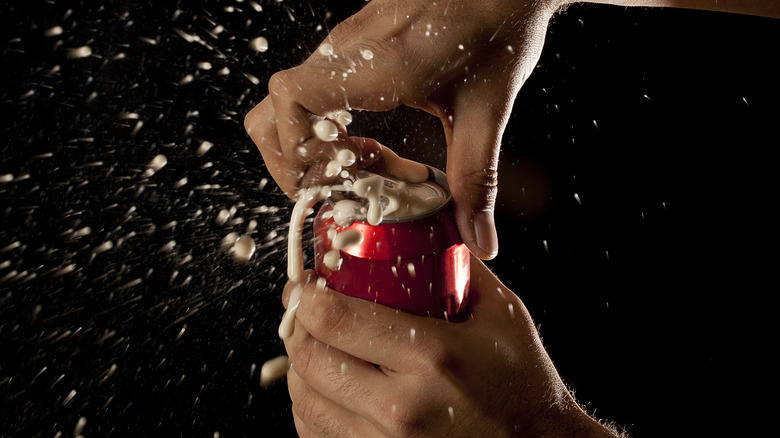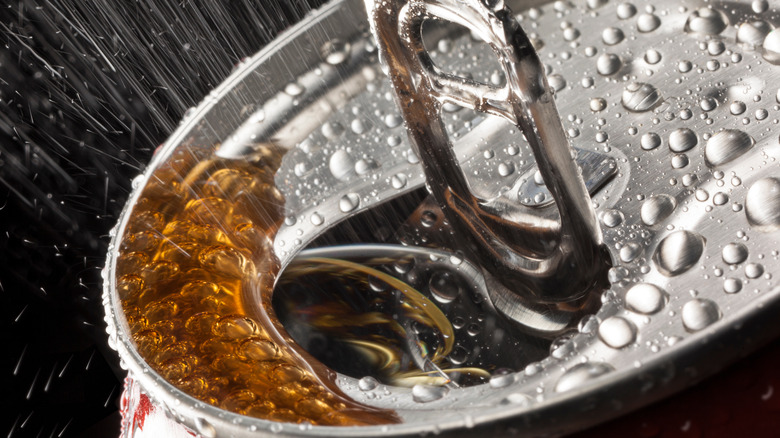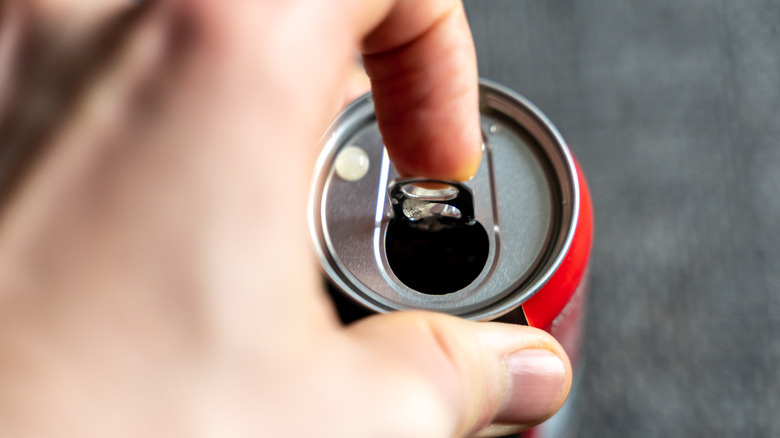How The Tapping Trick Stops Soda From Exploding
Almost everyone knows this trick, even if they don't understand why it works. But its effectiveness, to some degree, seems evident. Tapping repeatedly on the top of a can of carbonated beverage before opening it usually results in nothing happening — and that's the point. The goal of tapping is to prevent the soda from exploding in your face, or all over your clothes.
Just as carbon dioxide gas is the secret weapon that creates Champagne bubbles, it's also what gives water or soda their distinctive "fizzy" character, hence the term carbonation. The principle is the same for both Champagne and soft drinks. Carbon dioxide stays in perfect pressurized balance within the beverage while it's sealed. Once the cork is popped or the lid opened, this equilibrium is disrupted, causing gas to escape from the top, and bubbles to form in the beverage. When shaken, carbon dioxide gas bubbles form on the can's sides, rapidly expanding and potentially causing an explosive ejection of liquid upon opening.
It's not just a soda myth: Tapping the top of the can repeatedly really does help by pushing these troublesome gas bubbles from the can's sides to the top, where they sit above the soda line and are less likely to force liquid out when the can is opened. It's an elegant solution, although its effectiveness is often debated.
Why do soda cans explode and soda bottles don't?
There's a reason the tapping trick is commonly associated with soda cans and not bottles. Soda bottles, with their plastic twist caps instead of pull tabs, allow for a gradual release of the built-up carbon dioxide pressure, minimizing the risk of an explosion that's more common with cans. The trade off is that bottles don't retain carbonation as effectively as cans. They're more permeable, leading to a gradual loss of carbon dioxide over several months.
The pull-tab mechanism of soda cans doesn't permit this gradual pressure release. So, how long should you tap the top of a soda can to ensure it's safe to open? Generally, tapping for 10 to 15 seconds should do the trick, but the science behind this method is debated. Not only are there variables, like different carbonation levels in various soda brands, but inconsistent experimental results also make it less reliable. Additionally, factors such as time and temperature need to be taken into account.
Tapping isn't the only trick that works
Tapping the top of a soda can helps reduce the explosive effects of shaking, but it's not the only method that works. In fact, it's not even the most effective one. Some believe that snapping or flicking your finger against the sides of the can more effectively removes the problematic carbon dioxide bubbles that cling to the can than tapping the top.
However, the most effective method is simply time. Yes, allowing the can time to settle, enabling the carbon dioxide to be reabsorbed into the drink, is the best way to avoid a foamy explosion. It may not be as cool as tapping or snapping, but it yields better results. Additionally, maintaining the correct temperature for your drinks can prevent accidents. Warmer drinks are more likely to explode upon opening. Well-chilled ones? Not so much.
It's worth noting that a shaken soda can may take up to half an hour to settle to a point where it can be opened safely without foaming. So, if you're not willing to wait that long, go ahead and tap or snap away.



